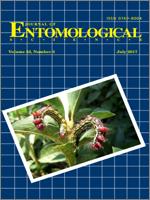Clostera anastomosis (L.) (Lepidoptera: Notodontidae) is an important leaf-feeding insect of poplars, Populus spp. (Salicaceae) in China. As part of a continuing search for environmentally friendly insecticides for this pest, we compared the in vitro inhibition of polyphenol oxidase (PPO) activity by 21 insecticides and allelochemicals in C. anastomosis and poplar trees (populous × euramericana ‘NanLin895′). The results showed that three inhibitors (quercetin, phenyl thiourea, and phoxim) can strongly inhibit PPO activity in both C. anastomosis and poplars, but the inhibitory degree with each was significantly different. Our results further showed that three inhibitors had a certain dose relationship with the PPO activity in C. anastomosis and poplars. The I50 values (50% inhibitory concentration) of three chemicals (quercetin, phenyl thiourea, and phoxim) were estimated as 14.17, 0.18, and 127.67 μM for C. anastomosis and as 0.34, 0.15, and 0.21 mM for poplars, respectively. These results will lay foundation for the design of effective, selective PPO inhibitors and the development of novel insecticides.
How to translate text using browser tools
1 July 2017
In Vitro Inhibition of Polyphenol Oxidase Activity by Insecticides and Allelochemicals in Clostera anastomosis (Lepidoptera: Notodontidae) Larvae and Poplar Trees
Xiaoling Shi,
Fang Tang,
Xizun Zhou,
Xing Bu
ACCESS THE FULL ARTICLE

Journal of Entomological Science
Vol. 52 • No. 3
July 2017
Vol. 52 • No. 3
July 2017
Clostera anastomosis
I50 values
inhibition
polyphenol oxidase
poplars




